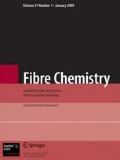Relationships are established between the parameters of mathematical models describing the change of electrical resistance of a thermoplastic polymer matrix filled with various types of conducting carbon particles and physical models allowing features of experimental concentration dependences of orientationally drawn composites to be explained. The difference between anisotropic and isotropic fillers is explained. The structuring mechanism of conducting chains of both types of fillers and their destruction with four- and eight-fold drawing of the polymer are illustrated.








Similar content being viewed by others
References
O. A. Moskalyuk, E. S. Tsobkallo, et al., in: Key Engineering Materials, New Polymer Composite Materials, Vol. 816, S. Khashirova, A. Zhansitov, et al. (eds.), Trans Tech Publications, 2019, pp. 244-249.
V. E. Gul’and L. Z. Shenfil’, Electrically Conducting Polymer Composites [in Russian], Khimiya, Moscow, 1984, 240 pp.
V. S. Krikorov and L. A. Kolmakova, Electrically Conducting Polymer Materials [in Russian], Energoatomizdat, Moscow, 1984, 176 pp.
A. S. Stepashkina, E. S. Tsobkallo, et al., Pis’ma Zh. Tekh. Fiz., 41, No. 2, 7-15 (2015).
O. A. Moskalyuk, A. N. Aleshin, et al., Fiz. Tverd. Tela, 54, No. 10, 1994-1998 (2012).
O. A. Moskalyuk, E. S. Tsobkallo, et al., Fibre Chem., 50, No. 3, 209-214 (2018).
E. S. Tsobkallo, O. A. Moskalyuk, et al., Khim. Volokna, No. 4, 22-27 (2018).
V. E. Sitnikova, S. D. Khizhnyak, et al., Khim. Volokna, No. 3, 87-92 (2015).
P. Zhang, Y. Bin, et al., Polymer J., 49, 839-850 (2017).
D. V. Vol’nova, E. S. Tsobkalo, and G. P. Meshcheryakova, Izv. Vyssh. Uchebn. Zaved., Tekhnol. Legk. Prom-sti, 43, No. 1, 15-18 (2019).
Author information
Authors and Affiliations
Corresponding author
Additional information
Translated from Khimicheskie Volokna, No. 3, pp. 8-14, May—June, 2020.
Rights and permissions
About this article
Cite this article
Tsobkallo, E.S., Vol’nova, D.V. & Meshcheryakova, G.P. Relationship of Mathematical and Structural Modeling of the Electrical Conducting Properties of Composite Film Fibers with Isotropic and Anisotropic Carbon Nanofillers. Fibre Chem 52, 141–147 (2020). https://doi.org/10.1007/s10692-020-10169-8
Published:
Issue Date:
DOI: https://doi.org/10.1007/s10692-020-10169-8




